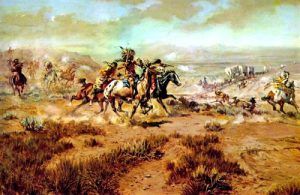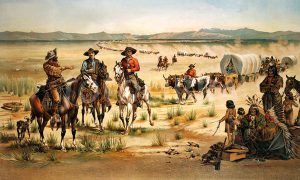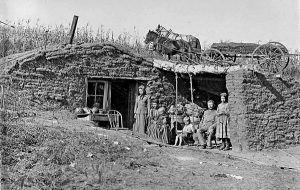
Attack on the Wagon Train hangs at the Gilcrease Museum, Charles Russell, artist, photo courtesy Gilcrease Museum
Blue Water/Ash Hollow Battle (1855)
Little Blue River Raid (August 7-9, 1864)
Eubank Homestead (August 7, 1864)
Plum Creek Massacre (August 8, 1864)
Little Blue/Oak Grove Station (August 9-10, 1864)
Kiowa Ranch Station (August 10, 1864)
Battle of Mud Springs (February 4-6, 1865)
Battle of Rush Creek (February 8-9, 1865)
Battle at Warbonnet Creek (1876)
Fort Robinson Massacre (1879)
Beginning in the early 18th century and ending with the conclusion of the Plains Indian wars of the 19th Century, Nebraska would see several bloody clashes between whites and Indians. Some of the first whites to visit what would later become the state of Nebraska were fur traders and explorers in the early 1820s. A decade later, more would come, including mountain men, traders, missionaries, and military expeditions. As the Oregon, California, and Mormon Trails developed, emigrants began to cross Nebraska in great numbers, especially after gold was discovered in California in 1849.
Even before it was legal, several white settlers began to make their homes in Nebraska, which was officially reserved for Indians. Naturally, this resulted in resentment from the many Plains tribes who called Nebraska home. There soon were demands made that the federal government organize Nebraska as a territory to legalize the settlements already there, and in 1854 the U.S. Congress passed the Kansas-Nebraska Act. This act created the Territory of Nebraska, which included Nebraska and parts of Colorado, Wyoming, Montana, and North and South Dakota. New towns were soon established, including Nebraska City, Plattsmouth, and Omaha. When Nebraska became a territory, an estimated 10,000 Indians lived there, most in permanent villages along the Missouri and Platte Rivers and their tributaries. However, there were several roving bands of Sioux in western Nebraska, and the Pawnee, who had ceded most of their lands to the government, were accustomed to utilizing the frontier as their hunting grounds.
Though the settlement was slow in the beginning, the pioneers continued to push in, leading to more and more conflicts with the Indians. One of the first significant clashes was the Battle of Ash Hollow, fought in western Nebraska in 1855. More skirmishes followed, and troops were sent to subdue the Indians in 1859. The Homestead Act in 1862 brought more settlers. During the Civil War, many regular troops were withdrawn from Plains military posts to fight in the east. The Sioux, Cheyenne, and Arapaho seizing this opportunity, attempted to drive white settlers from their land. Beginning on August 7, 1864, the Indians made concerted attacks on stage stations and ranches along the Oregon Trail, hitting nearly every settlement for 400 miles from Julesburg, Colorado, to Big Sandy, Nebraska. Travel ceased for two months. Troops and local militia companies attacked and drove back the Indians in the Battle of the Little Blue River on August 17, 1864. Major raids ceased, but skirmishes continued through the fall.
Throughout the next several decades, several skirmishes would take place between the Indians and the settlers as the Native tribes recognized that encroaching white men were killing their buffalo and transforming their homeland into sprawling settlements. The last Indian troubles on the Nebraska border ended with the Wounded Knee Massacre at the Pine Ridge Reservation in South Dakota on December 29, 1890.
© Kathy Alexander/Legends of America, updated November 2022.
Also See:
Indian Wars, Battles & Massacres
Indian Wars of the Frontier West by Emerson Hough


